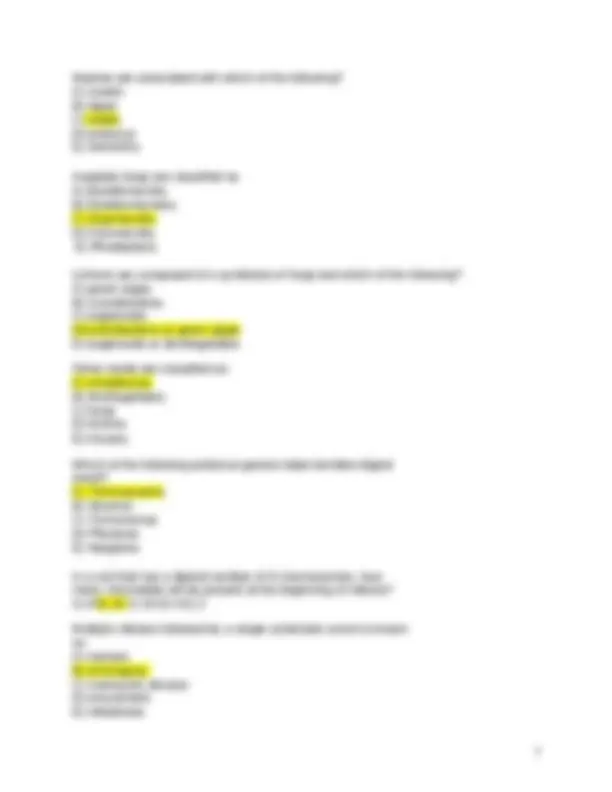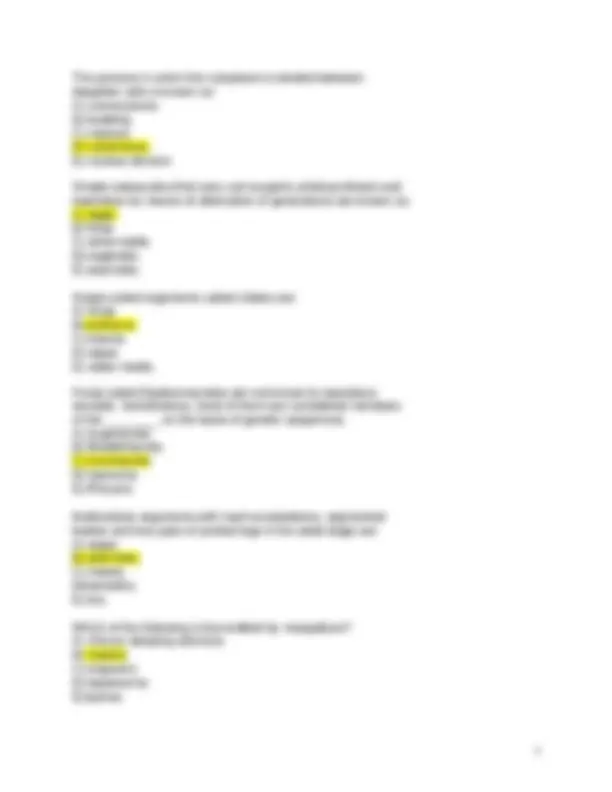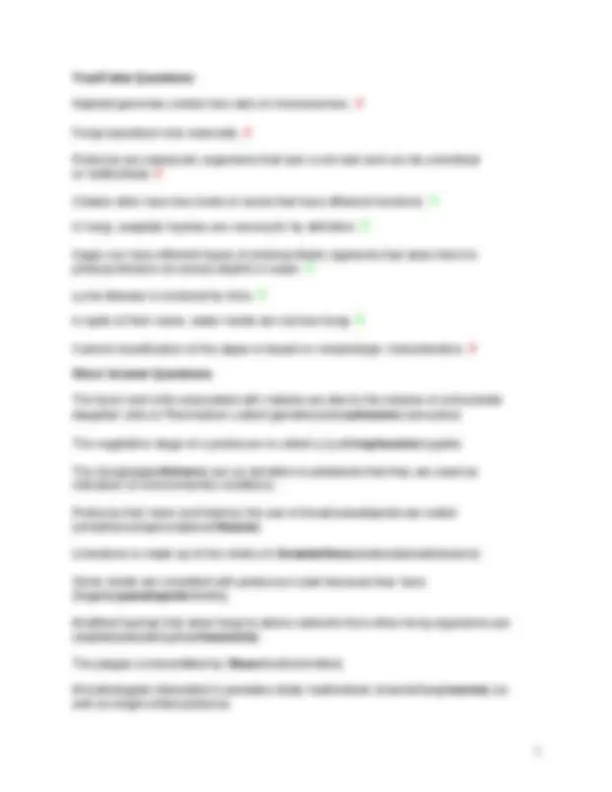





Study with the several resources on Docsity

Earn points by helping other students or get them with a premium plan


Prepare for your exams
Study with the several resources on Docsity

Earn points to download
Earn points by helping other students or get them with a premium plan
Community
Ask the community for help and clear up your study doubts
Discover the best universities in your country according to Docsity users
Free resources
Download our free guides on studying techniques, anxiety management strategies, and thesis advice from Docsity tutors
a full and detailed chapter summary of the chapter in the required book for readingare
Typology: Summaries
1 / 7

This page cannot be seen from the preview
Don't miss anything!




Chapter 12 Characterizing and Classifying Eukaryotes The fusion of two gametes produces A) zygote. B) schizont. C) chromatid. D)centromere. E) merozoite. Which of the following pairs is MISMATCHED? A) animals; usually diploid B) fungi; usually diploid C) protozoa; usually diploid D) slime mold; usually haploid E) plants; usually diploid Which of the following pairs is MISMATCHED? A) Diplomonadida; two nuclei B) Rhizaria; pseudopodia C) Parabasala; two mitochondria D) Euglenids; flagellum E) Ciliophora; cilia Which of the following is a protozoan stage that allows for transmission of intestinal parasites from one host to another? A) cyst B) merozoite C) schizont D) foraminifera E) kinetoplast Single-celled eukaryotes lacking a cell wall are A) protozoa. B) fungi. C) algae. D) insects. E) water molds. Which of the following is a protozoan with two nuclei and no mitochondria? A) Plasmodium B) Parameciu C) Euglena D) Giardia E) Trichomonas
Which of the following has NOT been a basis for classification of the protozoa? A) means of locomotion B) genetic sequences C) photosynthetic ability D) habitat E) ability to form a dormant stage The ________ is the entire interwoven mass of one multicellular fungal organism. A) hyphae B)sporangium C) mycelium D) pseudoplasmodium E) conidiophore The asexual spores of molds are classified according to their A) size. B) type of metabolism. C) number of chromosomes. D) shapes. E) mode of development. Which of the following is a cell type associated with sexual reproduction in fungi? A) sporangiospore B) dikaryon C) haustoria D) pneumocyst E) mycorrhiza Fungal spores produced asexually within a sac-like chamber at the tip of a hypha are called A) ascospores. B) basidiospores. C) sporangiospores. D) conidia. E) zygospores. The large seaweed known as kelp is classified as a member of the A) Chlorophyta. B) Phaeophyta. C) Chrysophyta. D) Rhodophyta. E) Deuteromycete.
The process in which the cytoplasm is divided between daughter cells is known as A) coenocytosis. B) budding. C) meiosis. D) cytokinesis. E) nuclear division Simple eukaryotes that carry out oxygenic photosynthesis and reproduce by means of alternation of generations are known as A) algae. B) fungi. C) slime molds. D) euglenids. E) arachnids. Single-celled organisms called ciliates are A) fungi. B) protozoa. C) insects. D) algae. E) water molds. Fungi called Deuteromycetes are not known to reproduce sexually. Nonetheless, most of them are considered members of the ________ on the basis of genetic sequences. A) Zygomycota B) Basidiomycota C) Ascomycota D) Sporozoa E) Rhizaria Multicellular organisms with hard exoskeletons, segmented bodies and four pairs of jointed legs in the adult stage are A) algae. B) arachnids. C) insects. D)helminths. E) lice. Which of the following is transmitted by mosquitoes? A) African sleeping sickness B) malaria C) ringworm D) tapeworms E) typhus
True/False Questions Haploid genomes contain two sets of chromosomes. F Fungi reproduce only asexually. F Protozoa are eukaryotic organisms that lack a cell wall and can be unicellular or multicellular. F Ciliates often have two kinds of nuclei that have different functions. T In fungi, aseptate hyphae are coenocytic by definition. T Algae can have different types of photosynthetic pigments that allow them to photosynthesize at various depths in water. T Lyme disease is vectored by ticks. T In spite of their name, water molds are not true fungi. T Current classification of the algae is based on morphologic characteristics. F Short Answer Questions The fever and chills associated with malaria are due to the release of uninucleate daughter cells of Plasmodium called (gametocytes/ schizonts /coencytes). The vegetative stage of a protozoan is called a (cyst/ trophozoite /zygote). The (fungi/algae/ lichens ) are so sensitive to pollutants that they are used as indicators of environmental conditions. Protozoa that move and feed by the use of broad pseudopods are called (amoebozoa/apicomplexa/ rhizaria ). Limestone is made up of the shells of ( foraminifera /parabasala/radiolarians). Slime molds are classified with protozoa in part because they have (flagella/ pseudopods /shells). Modified hyphae that allow fungi to derive nutrients from other living organisms are (septate/pseudohyphae/ haustoria ). The plague is transmitted by ( fleas /lice/ticks/mites). Microbiologists interested in parasites study multicellular (insects/fungi/ worms ) as well as single-celled protozoa.